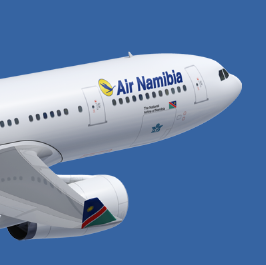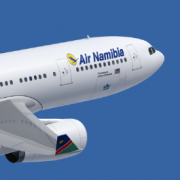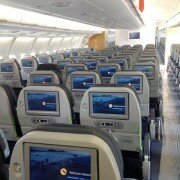Brand New Airbus A330-200.
THE COMPETITIVE EGDE OF AIR NAMIBIA’S
BRAND NEW AIRBUS A330-200 AIRCRAFT
Entry into service of the brand new Airbus A330-200s, to replace the aged Airbus A340-300, will reduce costs and boost revenue, while providing flexibility, a superior and improved cabin product for Air Namibia.
The airline industry is highly competitive and is constantly exposed to many risks; among them fuel price volatility, a rigorous regulated environment and safety compliance aspects. Passenger travel preferences and buying decisions have evolved over time to such an extent that today’s traveller has become very informed and sophisticated. These factors have made fleet decisions become crucial for any airline that aspires to improve financial performance, operational efficiency and compliance with safety and other regulatory requirements.

“Air Namibia believes that the decision to acquire two brand new Airbus A330-200s to replace the aged Airbus A340-300s, which entered its fleet 7 years ago in year 2006, is a step in that direction. This decision fits well in efforts to continually strive to improve operational efficiency, aligning the services of the airline to the needs of the market, match and even exceed competitor offerings so as to compete effectively, and to achieving acceptable financial performance within the resources that are available to it and striving towards at all times.”
The delivery of the new aircraft represents the last phase of the airline’s re-fleeting programme contained in its business plan adopted in July, 2011. Earlier re-fleeting initiatives included phasing out of the Beechcraft B1900 aircraft and replacing them with Embraer ERJ 135 Regional Jets in 2011, as well as phasing out of the aged Boeing B737 fleet and replacing them with new Airbus A319-100s.
“The new Airbus A330-200s will break the long history of Air Namibia operating quad powered aircraft (four engines) with twin-powered aircraft on its long haul operations between Namibia and Europe. These planes come with improved operating technologies which offer way much better savings on operating costs,” says Nakawa.
“In a few weeks’ time, gone will be the days when Air Namibia was seen as an operator of old aircraft retired by other airlines, which placed us as an underdog in the market when compared to our much bigger and highly resourced competitors,” he adds.
Even though older aircraft might have lower lease rates, total operating costs are higher when one takes into account the effect of fuel burn, maintenance costs, dispatch reliability and lost revenue from passengers selecting a competitor airline due to its newer cabin and inflight entertainment plus other amenities. Fleet selection affects both revenue and cost.
Another important consideration which went into the selection of the Airbus A330-200 as opposed to other aircraft options available is the “right sized” cabin configuration element, in terms of the number of seats in relation to Air Namibia’s “demand forecasting” outcomes. The new planes come with 30 business class seats and 214 economy class seats, giving a total of 244 seats. The soon to be phased out Airbus A340-300s have 278 seats in total, comprising 32 Business and 246 Economy Class. The current average passenger load per year on the Windhoek-Frankfurt route is 220 passengers, meaning that full value of the cost per seat is not being realised as some seats go unoccupied.
Larger aircraft have limited flexibility in the event that Air Namibia would like to deploy its long-haul aircraft on new markets and medium-range routes. While larger aircraft have a lower cost per seat, all the seats must be occupied for this low cost benefit to be realised. The A330-200s are more flexible aircraft to use on new routes/markets, while also offering modern and mature aviation technology. Being brand new, the aircraft are also a big boost to Air Namibia brand image and passenger confidence. The A340-300s will be over 25 years old by the time their lease arrangement expires in October.
The Airbus A330-200 offers much lower operating cost compared to the A340-300, given its Lower Maximum Take Off Weight of 230,000 kg compared to 257,000 kg of the A340-300, meaning lower landing fees, navigation charges, lower fuel burn, etc. The A330 offers the lowest fuel burn and the lowest maintenance costs of all options – given its size and the fact that it comes with two engines to maintain instead of four engines, and two engines consuming fuel on the A330 compared to four engines consume fuel on the A340s.
Passenger rating of the two aircrafts published on the Airbus website shows that 67% favour the A330-200 compared to a 33% preference for the A340-300.
Air Namibia is due to take delivery of the first of the two brand new Airbus A330-200 aircraft before the end of September 2013. The second A330-200 is expected to enter the national air carrier’s fleet in November 2013. The two aircraft are being leased from Intrepid Aviation for a period of 12 years.
Issued by:
Paulus Homateni Nakawa
Head: Corporate Communications
Tel.: +264 61 299 6298/6216/6215
E-Mail: [email protected]
–End-











